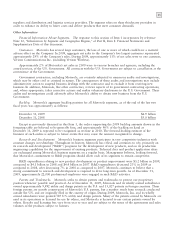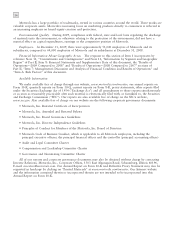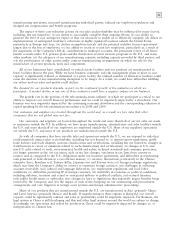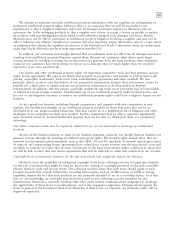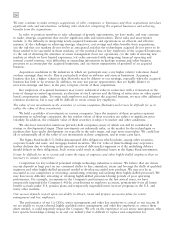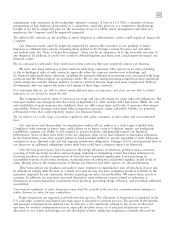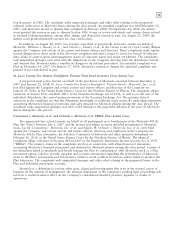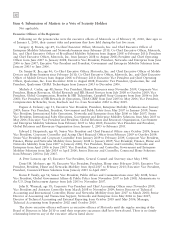Motorola 2009 Annual Report Download - page 30
Download and view the complete annual report
Please find page 30 of the 2009 Motorola annual report below. You can navigate through the pages in the report by either clicking on the pages listed below, or by using the keyword search tool below to find specific information within the annual report.
22
We also have presence in emerging markets such as Brazil, India and Russia. We face additional challenges in
emerging markets, including creating demand for our products and the negative impact of changes in the laws, or
the interpretation of the laws, in those countries.
We also are subject to risks that our operations outside the U.S. could be conducted by our employees,
contractors, representatives or agents in ways that violate the Foreign Corrupt Practices Act or other similar
anti-bribery laws. While we have polices and procedures to comply with these laws, our employees, contractors,
representatives and agents may take actions that violate our policies. Any such violations could have a negative
impact on our business. Moreover, we face additional risks that our anti-bribery policy and procedures may be
violated by third party sales representatives or other agents that help sell our products or provide other services,
because such representatives or agents are not our employees and it may be more difficult to oversee their
conduct.
Changes in our operations or sales outside the U.S. markets could result in lost benefits in impacted countries and
increase our cost of doing business.
The Company has entered into various agreements with non-U.S. governments, agencies or similar
organizations under which the Company receives certain benefits relating to its operations and/or sales in the
jurisdiction. If the Company’s circumstances change and operations or sales are not at levels originally
anticipated, the Company may be at risk of losing some or all of these benefits and increasing our cost of doing
business.
We may not generate sufficient future taxable income, which may require additional deferred tax asset valuation
allowances.
If the Company is unable to generate sufficient future taxable income in the U.S. and certain other
jurisdictions, or if there are significant changes in tax laws or in the actual effective tax rates or the time period
within which the underlying temporary differences become taxable or deductible, the Company could be required
to increase its valuation allowances against its deferred tax assets resulting in an increase in its effective tax rate
and a negative impact on future operating results.
If the quality of our products does not meet our customers’ expectations, then our sales and operating earnings,
and ultimately our reputation, could be negatively impacted.
Some of the products we sell may have quality issues resulting from the design or manufacture of the
product, or from the software used in the product. Sometimes, these issues may be caused by components we
purchase from other manufacturers or suppliers. Often these issues are identified prior to the shipment of the
products and may cause delays in shipping products to customers, or even the cancellation of orders by
customers. Sometimes, we discover quality issues in the products after they have been shipped to our customers,
distributors or end-users, requiring us to resolve such issues in a timely manner that is the least disruptive to our
customers. Such pre-shipment and post-shipment quality issues can have legal and financial ramifications,
including: delays in the recognition of revenue, loss of revenue or future orders, customer-imposed penalties on
Motorola for failure to meet contractual requirements, increased costs associated with repairing or replacing
products, and a negative impact on our goodwill and brand name reputation.
In some cases, if the quality issue affects the product’s safety or regulatory compliance, then such a
‘‘defective’’ product may need to be recalled. Depending on the nature of the defect and the number of products
in the field, it could cause the Company to incur substantial recall costs, in addition to the costs associated with
the potential loss of future orders and the damage to the Company’s goodwill or brand reputation. In addition,
the Company may be required, under certain customer contracts, to pay damages for failed performance that
might exceed the revenue that the Company receives from the contracts. Recalls involving regulatory agencies
could also result in fines and additional costs. Finally, recalls could result in third-party litigation, including class
action litigation by persons alleging common harm resulting from the purchase of the products.
If the volume of our sales decrease or do not reach projected targets, we could face increased materials and
manufacturing costs that may make our products less competitive.
We have negotiated favorable pricing terms with many of our suppliers, some of which have volume-based
pricing. In the case of volume-based pricing arrangements, we may experience higher than anticipated costs if
current volume-based purchase projections are not met. Some contracts have minimum purchase commitments
and we may incur large financial penalties if these commitments are not met. We also may have unused
production capacity if our current volume projections are not met, increasing our production cost per unit. In the





